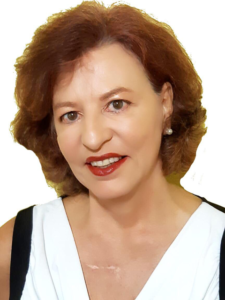
BY BEATRIZ NASCIMENTO, SAO PAOLO, BRAZIL
I had some mild muscle weakness since childhood, but in my 20s everything was getting harder. I was constantly fatigued and stressed. By my early 30s, fast decline in muscle functions due to FSH muscular dystrophy was making me believe that the rest of my life would be a painful downhill trip toward more weakness, limitations, and paralysis.

As a full-time professor of occupational therapy at Federal University of San Carlos, Brazil, I had already explored what conventional medicine and mainstream rehabilitation had to offer, and it was not nearly enough. When I read Meir Schneider’s Movement for Self-Healing, it became clear that I had to try it. Meir had overcome his blindness by working incredibly hard on his eyes, and he applied those principles to serious diseases, including muscular dystrophy. I promised my department to bring back the technique if they gave me a grant to study with Meir. That is how I ended up in San Francisco in 1989.
Throughout nine months at the School for Self-Healing I lived entirely from my body’s perspective. In addition to classes, I averaged four hours daily of gentle movements, self-massage, stretches, breathing, and visualization. I rested and enjoyed myself with music and inspirational media. I also received massage, which prepared the muscles to repeat the movements many times. There was emphasis on body awareness and on activating muscles that were not being used. My body felt that it was finally receiving what it needed.
Feed the mind, move the body
I experienced remarkable progress in my overall health, movement patterns, and flexibility, and estimated that I was about 40 percent better after only nine months of work. Here are some of the improvements I experienced:
- Raising my arms up about 150 degrees; previously I could not pass 90 (shoulder level).
- More control of my arms and hands, no more dropping objects.
- Walking for longer distances without stumbling, feeling fatigued, and achy.
- Straighter posture, shoulders no longer protruded and lower back less arched.
- Chewing and smiling easier.
- Lighter and more graceful movements.
I was no longer stressed out and physically exhausted like I had been in the previous years. Instead, I was relaxed, happy, and full of enthusiasm to spread this work not only in Brazil, but to the world. People need to know that options for a higher quality of life are available now! This has been my purpose for the past 30 years.
Maintaining benefits in daily life
Being back at a very demanding job, armed with my new life’s mission, brought less improvement and new challenges. My position at the university allowed the work to spread quickly. I traveled giving lectures, workshops, and trainings, translated materials, and worked with clients. In 2001 we created the Brazilian Self-Healing Association, with more than a hundred members spreading the good word.
Like every adult, I had to face many other life crises, which caused the disease to advance faster. Literature corroborates my experience that stress is very damaging for people with degenerative conditions because it weakens the body. We must learn how to alleviate the stress and constantly adjust the delicate balance among the needs of the body, daily exercises, family, social life, and attacks from the disease.
I was not always successful in doing that, but from time to time did short intensives of bodywork. It is remarkable that during all these intensives I experienced a shift between “going downhill” to “feeling healthy and fresh” again, while regaining some of the losses. It works like a reset button, proving that every time we do the work, we gain the results.
It is very empowering to know that we can bring comfort and pleasure to our bodies, even as the disease progresses and the body changes.
Some examples of what I do when I am fatigued and stressed are:
- floating and moving very gently in warm water;
- receiving a supportive self-healing massage;
- gently stretching and moving in all directions to give the joints more freedom;
- self-massage;
- deepening my breathing with movement, massage, and awareness; and
- visualizations and meditation.
I also exercise more vigorously the areas that are not very affected, but this can be tricky! I believe it is safer and more productive to do more repetition with less resistance, using our full range of motion, moving in different angles and planes. Water allows for endless adjustment in resistance, and it is fun. Water is my all-time favorite!
All of this works synergistically to replenish the body’s energy
Self-healing is not a magic bullet, and muscular dystrophy is not an easy condition to treat. It takes dedication and commitment on a daily basis, and this may not be feasible for many. It is like practicing to become a piano virtuoso, and not everyone can do it, but for those who wish to try, I share my story as a way to offer encouragement.
Recently, meditation has also been a big part of my life, giving me the tools to calm the mind, rest more deeply, and live fully in the present, instead of comparing things to the past or worrying about the future. Whenever exhaustion and hopelessness kick in, meditation dissipates it, allowing peace and happiness to enter. I highly recommend it.
Now at 60, I want to focus on creating materials that will outlive me, giving people with debilitating diseases inspiration and empowerment to move easier, feel better, and live life to its fullest.


What an encouraging story. I am 74 and was diagnosed with FSHD 10 years ago. I am desperate in need of exercise which I can do at home . My right calf muscles were first affected as well as left side of my face.Lately I also noticed that my left leg is also deteriorating slowly. I still drive my car,do my home chores etc.But walking is difficult .Any suggestions how I can keep going. Also not sure whether I should take the vaccine against Covid. Would appreciate any advice.
Please check out our resource on physical therapy and exercise to see if there are activities that are suitable. Exercise safely!
https://www.fshdsociety.org/exercise-and-fitness/
We also think FSHD patients should get the COVID vaccination. The risk posed by the virus itself is far more serious than the risk posed by the vaccination. See our article about this:
https://www.fshdsociety.org/2021/01/27/covid-vaccine/